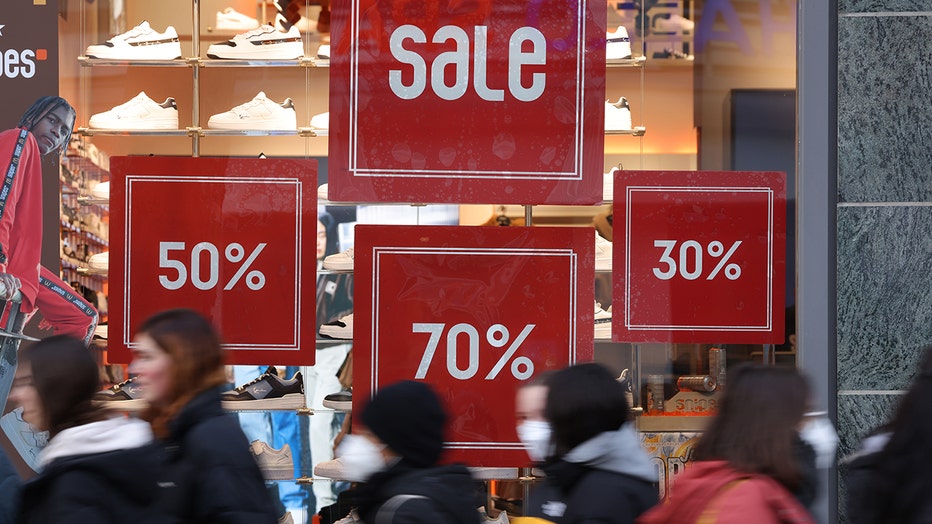US consumer inflation eased in October, driven by cheaper gas, cars and airfares
Inflation in the United States slowed last month in a sign that the Federal Reserve’s interest rate hikes are continuing to cool the consumer price spikes that have bedeviled consumers for the past two years.
Tuesday’s report from the Labor Department showed that prices either fell or rose more slowly across a broad range of goods and services, including gas, new and used cars, hotel rooms and housing. Overall inflation was unchanged from September to October, down from the 0.4% jump the previous month. Compared with 12 months ago, consumer prices rose 3.2% in October, down from the 3.7% rise in September and the smallest year-over-year increase since June.
Excluding volatile food and energy prices, so-called core prices also slowed. They rose just 0.2% from September to October, slightly below the pace of the previous two months. Economists closely track core prices, which are thought to provide a good sign of inflation’s future path. Measured year over year, core prices rose 4% in October, down from 4.1% in September, the smallest rise in two years.
"The inflation fever has broken," said Bill Adams, chief economist at Comerica Bank. "Rising petroleum production is holding down gas prices, house prices are rising more slowly after mortgage rates surged in 2023 and rents are also rising more gradually" as more apartment buildings are completed.

Shoppers walk past retail shops offering sales. (Credit: Sean Gallup/Getty Images)
Gas prices fell 5% from September to October and are down 5.3% from a year earlier. They have continued to fall into November, suggesting that cheaper energy could hold down inflation this month as well. Prices at the pump averaged $3.35 Tuesday, down 42 cents from a year earlier.
Grocery store prices rose 0.3% last month and 2.1% from a year earlier. Though still above pre-pandemic inflation, the year-over-year rise is down from double-digit increases earlier this year. Bread and beef prices surged in October and are much more expensive than they were a year ago. Milk and egg costs ticked higher last month but have fallen compared with a year earlier.
October’s milder-than-expected price figures make it much less likely that the Fed will impose another rate hike, economists said. Fed officials, led by Chair Jerome Powell, are considering whether their benchmark rate is high enough to quell inflation or if they need to impose another increase in coming months.
Powell had said last week that Fed officials were "not confident" that rates were sufficiently high to tame inflation. The Fed has raised its benchmark interest rate 11 times in the past year and a half, to about 5.4%, the highest level in 22 years.
But the central bank has raised its key rate just once since May. Since its last meeting on Nov. 1, a government report showed that hiring cooled in October compared with September, and wage growth slowed, thereby easing pressure on companies to raise prices in the coming months.
Adams, echoing other economists, said he thinks the Fed's most likely next move will be to cut rates, likely by mid-2024.
RELATED: Majority of Americans take notice in the rise of 'tipflation' across industries
The prospect that the Fed may end its rate hike campaign and eventually cut rates fueled a stock market rally Tuesday. The Dow Jones industrial average soared nearly 1.5% in mid-morning trading. The yield on the benchmark 10-year Treasury note fell to 4.44%, down from nearly 4.6%, reflecting investors' expectations that borrowing rates will move lower.
The Fed’s rate hikes have increased the costs of mortgages, auto loans, credit cards and many forms of business borrowing, part of a concerted drive to slow growth and cool inflation pressures. The central bank is trying to achieve a "soft landing" — raising borrowing costs just enough to curb inflation without tipping the economy into a deep recession.
"Things are proceeding in a way that is very consistent with what (the Fed) would want to see," said Eric Winograd, chief economist at AB Global, an asset management firm. "They look like they are on course to generate a soft landing. There’s no guarantee that they will actually manage to accomplish it. But right now, that’s the story that the data are telling."
Prices first accelerated in 2021 as consumers stepped up spending amid a fading pandemic. Much greater demand ran headlong into snarled supply chains, which led retailers and other companies to quickly jack up prices. Inflation has since eased as supply chains have improved and higher borrowing rates have weakened some industries, notably housing.
Improved supply chains have helped reduce the prices of new and used vehicles, with used-car prices falling for five straight months. New car prices fell 0.1% in October despite worries among many economists that the now-settled autoworkers' strike would reduce dealer inventories and force up prices.
The costs of apartment rents and overall housing also slowed in October after an uptick in September. Rents rose just 0.3% from September to October, half the pace of the previous month. Compared with a year ago, rents are still up 6.7%, a sizable increase that has made housing less affordable. Even with the smaller increase, rental and housing costs accounted for two-thirds of the increase in core inflation compared with a year ago.
Many economists say a key reason why most Americans hold a gloomy view of the economy despite very low unemployment and steady hiring is that the costs of things they buy regularly — gas, meat, bread and other groceries — remain much higher than they were three years ago.

